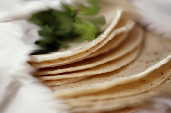
About Tortilla & History!
-
Enchillada
-
Tacos
Tortilla - a thin pancake made from cornmeal.
Named by the Spanish conquistators - tortillas are an important part of the diet in South American countries. In Spanish cookery a tortilla is a flat omelette usually filled with potatoes, onions, or salt cod, which is cut into quarters like a cake.
Traditionally grilled on earthenware utensils, they are used as bread and often filled and stuffed. The original indian method of preparation consisted of kneading the cornmeal dough (masa) on a stone called a metate and then shaping into circles 8 inches wide (20cm) and 1/8inch thick (3mm). Tortillas can be bought ready made cooked or raw. Fillings include guacomole, fajitas, grated cheese (queso), tomato salsa, chopped raw onions, picadillo (spicy meat sauce).
Main dishes include:
Tacos: where the tortilla is used as a sandwich,
Enchiladas: where the filling is rolled in tortilla then coated with sauce and cooked in an oven.
Chilaquiles: thin fried strips of tortilla coated with sauce and cooked in an oven.
Quesadillas: tortilla is filled folded into turnovers and then fried.
Mexican breakfast: fried eggs on fried tortillas garnished with tomatoes, crushed red pepers and avocado slices.
The Conquest of Mexico by Spain in 1521 gave rise to one of the greatest culinary revolutions in history. When the Spanish explorer Cortez and his followers came to the new world in search of fortune, they found a wealth of new foods such as chocolate, peanuts, vanilla, beans, squash, avocados, coconuts, corn and tomatoes. In turn the Spanish brought to the Americas products such as pork, beef, lamb, citrus fruits, garlic, cheese, milk, wheat, vinegar and wine.
Montezuma, the great Aztec emperor, was previously warned that one day bearded men mounted on animals like giant deer would come to take over his domain, so when Montezuma heard that men had landed at Vera Cruz he was not surprised. He made every effort to keep them in Vera Cruz by offering them great riches, but after seeing the riches it spurred them on to see where the riches came from. On November 8, 1519, Cortez entered Montezuma's capitol along with seven thousand native soldiers he had recruited along the way.
He was received by Montezuma and given a great feast, but the cordial relations between the Spanish captain and the Aztec emperor were short lived. After many bloody battles, on August 13th 1521, Cortez claimed the capitol. The conquerors systematically destroyed the Aztec empire and replaced it with Spanish structures and Institutions, but they never succeeded in extinguishing the native culture and traditions, which are still part of Mexico today.
The emerging Mexican cuisine was constantly being enriched from many different countries. Recipes and ingredients from Africa, South America, Caribbean, France and the orient found there way through the Spanish - Mexico conduit.
How tortillas are traditionally made
Chilli Facts
Some early Spanish priests, aware of the passion the native people had for Chillis and unsure of the Chilli's powers, assumed that they were aphrodisiacs and warned against consumption this probably added to their popularity among the adventurous newcomers.
Eating chillies is addictive. When capsaicin comes in contact with the nerves in your mouth, pain signals are sent to the brain. Subsequently, the brain releases endorphins, natural painkillers, that create a feeling of well being. The more spicy food ingested the more endorphins released. The effect is a pleasurable feeling that a true Chilli-head craves.
The best relief for a burning mouth is mild yogurt or sour cream. These foods contain casein, a protein that breaks down the bond that capsaicin forms with the mouth's pain receptors.
How tortillas are traditionally made
